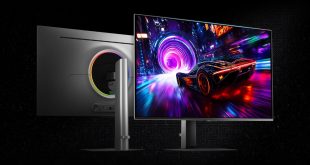The Blu-ray disc association (BDA) has been working on a new BD specification that supports ultra-high-definition (UHD) 4K resolution for about a year now. Apparently, the organization is on-track with formal announcement of Ultra HD Blu-ray disc standard in the second quarter of 2015, according to a media report.
The new Ultra HD Blu-ray disc standard will, as expected, use H.265/HEVC codec as well as Blu-ray media with 33GB layers, which is similar to the BD XL optical discs, something that Samsung proposed to use last year. Dual-layer UHD BD media will feature 66GB capacity, whereas triple-layer media will sport 100GB capacity. For some reason, members of the BDA decided not to support quad-layer discs that can store up to 133GB of data. The UHD Blu-ray disc specification will support ultra-HD resolutions with 60Hz refresh rate, 10-bit colour and other features, reports DigiTimes citing spokespeople from Panasonic. Unfortunately, it looks like 12-bit colour encoding will not be a part of the new spec.
While it is guaranteed that the new Blu-ray 4K UHD standard will support 3840*2160 resolution of current 4K televisions and computer displays, it is unclear whether it will support 4096*2160 resolution, which is the “official” 4K resolution of Digital Cinema Initiatives (DCI), a joint venture of major motion picture studios, formed to establish a standard architecture for digital cinema systems.
Ultra HD Blu-ray Disc players will support HDMI 2.0 and all-new system-on-chips that support H.265/HEVC codec along with other technologies that will be a part of the UHD Blu-ray specifications. While there are numerous H.265/HEVC-supporting SoCs for TVs on the market already, it is unknown whether they will be compatible with the official BDA’s Ultra HD Blu-ray standard.
Last year a BDA official said that the new ultra-high-definition Blu-ray disc technology would offer much more than just higher resolution. Among the key things are support for deeper colours, high-dynamic range, new content protection technologies and a way to enjoy UHD content on mobile devices.
“As with the original specs, we need to make sure that we will deliver 4K/UHD performance that’s second to none, as this is what everyone will expect from Blu-ray,” said Victor Matsuda, the BDA’s global promotions committee chairman. “This means not just looking at delivering the requisite number of pixels, but at the range of features that contribute to the overall consumer experience – factors such as high dynamic range, bit depth, color gamut, content protection and mobility and digital bridge opportunities that encourage content ownership and collection and enable flexible enjoyment of that content in mobile environments. We’re looking at the entire range and will be prepared to talk about those features as the specification approaches completion.”
If the BDA announces its new UHD BD specification in the second quarter of 2014, then actual players will emerge by the end of the year. Typically, first-generation consumer electronics devices are overpriced. Moreover, availability of content on ultra-high-definition Blu-ray media will be limited.
Discuss on our Facebook page, HERE.
KitGuru Says: While it is logical that the BDA decided not to wait till Sony and Panasonic develop their new optical disc standard with recording capacity of at least 300GB per disc (which is expected to be ready by late 2015 and which will be required for 8K UHD movies in 7680*4320 resolution several years from now), it is rather surprising that the Blu-ray disc association decided not to use 133GB media for the UHD BD standard.
 KitGuru KitGuru.net – Tech News | Hardware News | Hardware Reviews | IOS | Mobile | Gaming | Graphics Cards
KitGuru KitGuru.net – Tech News | Hardware News | Hardware Reviews | IOS | Mobile | Gaming | Graphics Cards




You got the year wrong, in the last main paragraph:
“If the BDA announces its new UHD BD specification in the second quarter of 2014”
while im late to the party comments its clear that these proprietary Blu-ray disc association are not fit for purpose as its clear that even the newest streaming prosumer is going to require far higher freq/Hz that the antiquate 60Hz/fps see
http://www.bbc.co.uk/rd/blog/2013/06/defining-the-future-of-television
and official EBU test sequences are available up to 12_EBU_ZurichAthletics2014_UHD_300p_HDR 3840×2160 360° “300 fps” 3026 52636-55635 and beyond. of insight of where its going (weather you like it or not 🙂
Especially https://tech.ebu.ch/docs/testmaterial/ebu_test_sequences_tech_info_170315.pdf
the minimum spec for the semi pro streamer in 2016 2020 is here too
https://tech.ebu.ch/docs/groups/jtnm/JT-NM%20MVS%20Report%20150303.pdf
Joint Task Force on Networked Media (JT-NM)
Minimum Viable System Requirements Of a Sample System Architecture for Live Multi-Camera Studio Production…
Video Format Resolution – The system shall be capable of carrying video payload of any
resolution up to the size of UHDTV2 (7680 x 4320).
Video Image Rate – The system shall be capable of carrying video payload of any frame or
field rate up to 300 Hz, and shall be capable of carrying NTSC style fractional frame rates at
multiples of (1000/1001).
Video Sample Depth – The system shall be capable of carrying video payload sample depths of
10 or 12 bits.
Video Chroma Sampling – The system shall be capable of carrying a video payload of 4:2:2 or
4:4:4 chroma sampling.
Alpha Channel – The system shall be capable of carrying a video payload that contains an
Alpha Channel (a component that represents transparency).
Color Spaces – The system shall be capable of carrying video payload in the color space of
ITU-R Rec. BT.601, ITU-R Rec. BT.709, and ITU-R Rec. BT.2020.